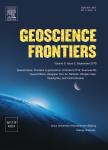Geophysical lineaments of Western Ghats and adjoining coastal areas of central Kerala,southern India and their temporal development
Geophysical lineaments of Western Ghats and adjoining coastal areas of central Kerala, southern India and their temporal development作者机构:Department of Marine Geology and GeophysicsCochin University of Science and TechnologyCochinKerala682 016India Sree BaghAmmankovil RoadCochinKerala682 035India
出 版 物:《Geoscience Frontiers》 (地学前缘(英文版))
年 卷 期:2017年第8卷第5期
页 面:1089-1104页
核心收录:
学科分类:070904[理学-构造地质学] 070801[理学-固体地球物理学] 0709[理学-地质学] 07[理学] 0708[理学-地球物理学] 0704[理学-天文学]
主 题:Magnetic anomalies Gravity anomalies Periyar plateau Tectonic lineaments Himalayan back-thrust Epeirogenic forces
摘 要:A family of geophysical lineaments have been identified in ~15,000 km^2 in central Kerala between9 30 N to 10 45 N and 76 00 E to 77°30′E,integrating geophysical data with geological and geomorphological features. The characteristics of these lineaments in the magnetic and gravity fields and their derivatives have been analysed. The evolution of the lineaments has been traced to the temporal phases of global evolution of the region. A group of these faults have formed by reactivation of the deep-seated distensional fractures associated with and accompanying dyke emplacements during the episodic breakup of Gondwana at ~90 and 65 Ma under distinctive mantle thermal regimes. It is possible that reactivation of these distensional faults may have started during the cooling interval of time between the two distensions in the 90 and 65 Ma and post 65 Ma periods and later in the Cenozoic, when the lineaments were enlarged to their present dimension, possibly under the influence of forces that led to the uplift of the western Ghats. These may extend down to the crust-mantle interface. A cluster of youngergeophysical lineaments has been generated by reactivation along the weak planes of transformation of the charnockitic rocks of the Precambrian. They seem to have a strike-slip character. They are devoid of any dyke association and were formed on a cold crust. They may be confined to the upper-middle *** were generated in the high intensity intra-plate palaeo-stress fields of the triple forces arising from(1) the back-thrust from the Himalayan Collision;(2) the impact of epeirogenic forces and related isostatic uplift of the Western Ghats and(3) the flexural isostatic uplifts due to surface loads of late Mesozoic basaltic lavas and Cenozoic sedimentation in the coastal rifted basins in late Cenozoic, probably in the time span of 20 Ma to the present, when the palaeostress fields were most intense.



